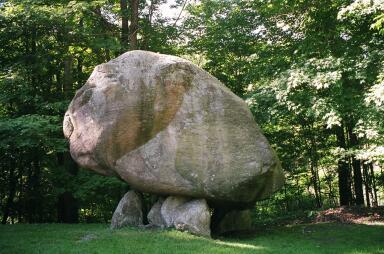[< Gallery Home | Latest Images | Top 100 | Submit Picture >]
258331 Pictures
|
<< Previous Picture | Next Picture >>
Description
This famous boulder, in New York State, was featured on the cover of an album by Robin Williamson, of Incredible String Band fame (fame?). My suspicions that it is a natural feature were put aside when I finally got to see it in person. The stone holding it up are very similarly shaped to one another, and no stones nearby resemble them at all. The whole structure is aesthetically pleasing from all angles. Worth a visit.
Posted Comments:
aluta (2004-07-29)
Until we took the photo, we hadn't noticed the interesting striped pattern, probably caused by weathering.
Antiquarian Society (2004-11-20)
This Stone looks remarkably like a Dolmen Construction i have seen in Korea. The megalithic culture was worldwide?
Thorgrim (2004-11-20)
Its a natural erratic dropped by a glacier.
aluta (2004-11-22)
Thorgrim?
Cody Brown (2005-02-18)
Hi,
My name is Cody Brown and I attend High Tech High School. I was wondering if I could use the image on your site of the boulder for a non-profit school project. Please respond at tbrown@hightechhigh.org as soon as possible. Thank you..
Sincerely,
Cody Brown
Here is a link of the pic.
http://www.megalithic.co.uk/a558/a312/gallery/USA/Roll2008.jpg
enkidu41 (2005-02-18)
A very interesting picture but the proportions look all wrong. Not only do the supports look absurdly small for their supposed purpose but the "capstone" doesn't appear to have been shaped by human hand at all and looks just like what Thorgrim suggests it is - a glacially deposited natural erratic boulder.
Thorgrim (2005-02-18)
Hi Cody - I am sure that no one will object to you using the image for your school project, but I have contacted Aluta (the photographer) on your behalf. Boulders left lying on smaller stones do look as if they have been placed there by man. Imagine an area of many smaller stones with a glacier slowly moving over them. Then the ice melts and a large boulder in the ice is left on top of the smaller stones. Over time, water erosion moves the other smaller stones away. The only smaller stones that remain are those that have been trapped by the weight of the boulder above them. We have many like this in Britain.
aluta (2005-03-02)
Bear in mind that the structures we find here (North America) were built by cultures alien to those in Europe. Methods, reasons, uses, all were very different. To judge structures here by European standards, and without seeing them first hand is a mistake. I do not rule out the possibility of this being a glacial erratic, but close examination of the structure certainly makes that conclusion less easy to leap to.
Also, the important context of the widespread stonework of the eastern seaboard is missing in a photo like this.
Thorgrim's out-of-hand dismissal of (in the case of this boulder) many others' observations and opinions is unlike the inquisitive and considerate attitude of the Megalithic Portal of past times.
Thorgrim (2005-03-02)
Come on now! "out of hand"? I have clearly explained how such glacial erratics are left sitting on smaller stones.
davidmorgan (2007-02-13)
That stone is HUGE!
Nick- (2007-02-20)
That is an enormous Glacial erratic! Huge compared to the one I saw in the Pyrenées in December.... One needs a person or something else possibly for scale!The grass and trees provide some though.... Nice photo !
Nick- (2007-02-20)
And yes, it may not be a glacial erratic.....
RSleepy (2008-01-15)
Well I'm not qualified to tell if it as a glacial erratic or a man-made structure - both sound possible. If it is an erratic maybe the smaller stones were smoothed by the ice etc? But why are they pointy end up? Intriguing... thanks for posting all this info on US sites.
aluta (2008-01-17)
Certainly some Finnish people see it as man made. See here. Of course in Finland these structures, sometimes called flying stones or chicken and eggs, are more common and often placed so that it is obvious they are artificially constructed.
holger rix (2010-11-27)
It looks like Bakkebølle Langdysse 2:
http://www.megalithic.co.uk/modules.php?op=modload&name=a312&file=index&do=showpic&pid=70812
http://www.megalithic.co.uk/modules.php?op=modload&name=a312&file=index&do=showpic&pid=70812
PERKYPUFFIN (2019-07-15)
Definitely a man balanced rock probably 3500 BC to 2000 BC era. One comment suggest it was painted to which I entirely agree. probably two colours a red/orange pigment and a dark blue/black. West Wales have similar balance stones.
To post comments first you must Register!

